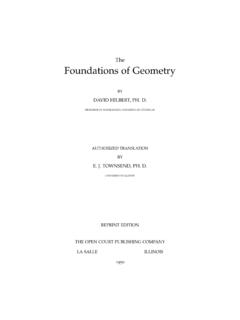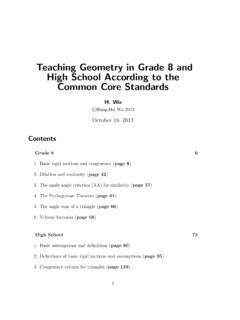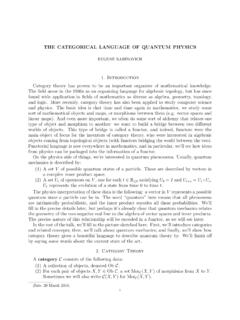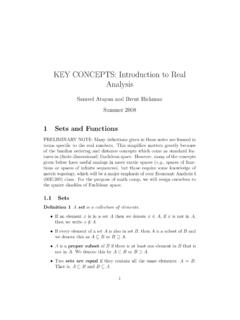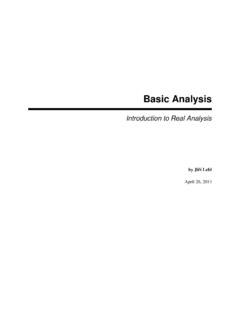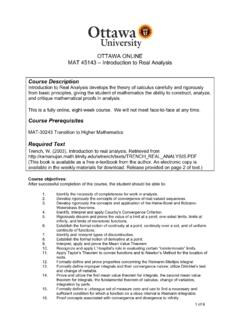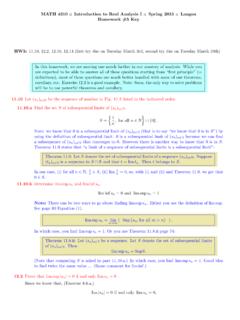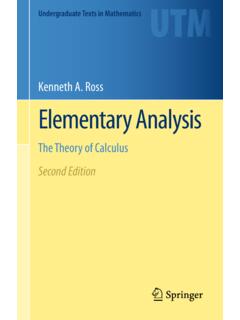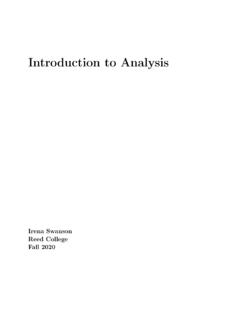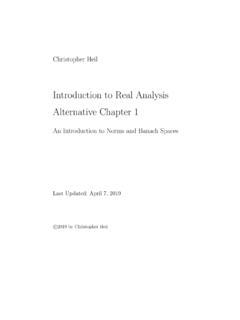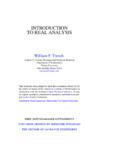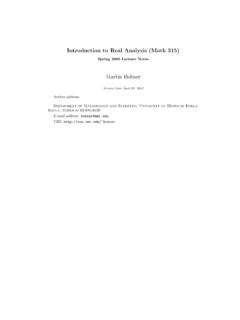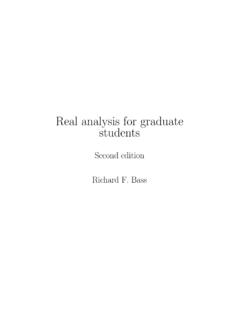Transcription of Basic Analysis: Introduction to Real Analysis
1 Basic AnalysisIntroduction to real Analysisby Ji r LeblFebruary 29, 2016(version )2 Typeset in 2009 2016 Ji r LeblThis work is licensed under the Creative Commons Attribution-Noncommercial-Share Alike States License. To view a copy of this license, send a letter to Creative Commons, 171 Second Street, Suite300, San Francisco, California, 94105, can use, print, duplicate, share these notes as much as you want. You can base your own noteson these and reuse parts if you keep the license the same. If you plan to use these commercially (sellthem for more than just duplicating cost), then you need to contact me and we will work somethingout. If you are printing a course pack for your students, then it is fine if the duplication service ischarging a fee for printing and selling the printed copy. I consider that duplicating the writing of these notes, the author was in part supported by NSF grants DMS-0900885and date is the main identifier of version.
2 The major version / edition number is raised only if therehave been substantial changes. Edition number started at 4, that is, version , as it was not kepttrack of more information (including contact information). this book .. Analysis .. set theory ..81 real properties .. set of real numbers .. value .. and the size ofR.. representation of the reals .. 392 Sequences and and limits .. about limits of sequences .. superior, limit inferior, and Bolzano-Weierstrass .. sequences .. on series .. 873 Continuous of functions .. functions .. and intermediate value theorems .. continuity .. at infinity .. functions and continuity .. 1314 The derivative .. value theorem .. s theorem .. function theorem .. 1535 The Riemann Riemann integral.
3 Of the integral .. theorem of calculus .. logarithm and the exponential .. integrals .. 1866 Sequences of and uniform convergence .. of limits .. s theorem .. 2127 Metric spaces .. and closed sets .. and convergence .. and compactness .. functions .. point theorem and Picard s theorem again .. 248 Further About this bookThis book is a one semester course in Basic Analysis . It started its life as my lecture notes forteaching Math 444 at the University of Illinois at Urbana-Champaign (UIUC) in Fall semester I added the metric space chapter to teach Math 521 at University of Wisconsin Madison(UW). A prerequisite for this course is a Basic proof course, using for example [H], [F], or [DW].It should be possible to use the book for both a Basic course for students who do not necessarilywish to go to graduate school (such as UIUC 444), but also as a more advanced one-semester coursethat also covers topics such as metric spaces (such as UW 521).
4 Here are my suggestions for whatto cover in a semester course. For a slower course such as UIUC 444: , , , , , , a more rigorous course covering metric spaces that runs quite a bit faster (such as UW 521): , , , , , , , should also be possible to run a faster course without metric spaces covering all sections ofchapters 0 through 6. The approximate number of lectures given in the section notes through chapter6 are a very rough estimate and were designed for the slower course. The first few chapters of thebook can be used in an introductory proofs course as is for example done at Iowa State UniversityMath 201, where this book is used in conjunction with Hammack s Book of Proof [H].The book normally used for the class at UIUC is Bartle and Sherbert, Introduction to RealAnalysisthird edition [BS].
5 The structure of the beginning of the book somewhat follows thestandard syllabus of UIUC Math 444 and therefore has some similarities with [BS]. A majordifference is that we define the Riemann integral using Darboux sums and not tagged Darboux approach is far more appropriate for a course of this approach allows us to fit a course such as UIUC 444 within a semester and still spendsome extra time on the interchange of limits and end with Picard s theorem on the existence anduniqueness of solutions of ordinary differential equations. This theorem is a wonderful examplethat uses many results proved in the book. For more advanced students, material may be coveredfaster so that we arrive at metric spaces and prove Picard s theorem using the fixed point theorem asis excellent books exist. My favorite is Rudin s excellentPrinciples of MathematicalAnalysis[R2] or as it is commonly and lovingly calledbaby Rudin(to distinguish it from hisother great Analysis textbook).
6 I took a lot of inspiration and ideas from Rudin. However, Rudinis a bit more advanced and ambitious than this present course. For those that wish to continuemathematics, Rudin is a fine investment. An inexpensive and somewhat simpler alternative to Rudinis Rosenlicht sIntroduction to Analysis [R1]. There is also the freely downloadableIntroduction toReal Analysisby William Trench [T].A note about the style of some of the proofs: Many proofs traditionally done by contradiction,I prefer to do by a direct proof or by contrapositive. While the book does include proofs bycontradiction, I only do so when the contrapositive statement seemed too awkward, or whencontradiction follows rather quickly. In my opinion, contradiction is more likely to get beginningstudents into trouble, as we are talking about objects that do not try to avoid unnecessary formalism where it is unhelpful.
7 Furthermore, the proofs and thelanguage get slightly less formal as we progress through the book, as more and more details are leftout to avoid a general rule, I use:=instead of=to define an object rather than to simply show use this symbol rather more liberally than is usual for emphasis. I use it even when the context is local, that is, I may simply define a functionf(x):=x2for a single exercise or , I would like to acknowledge Jana Ma r kov , Glen Pugh, Paul Vojta, Frank Beatrous,S nmez Sahuto glu, Jim Brandt, Kenji Kozai, and Arthur Busch, for teaching with the book andgiving me lots of useful feedback. Frank Beatrous wrote the University of Pittsburgh versionextensions, which served as inspiration for many of the recent additions. I would also like tothank Dan Stoneham, Jeremy Sutter, Eliya Gwetta, Daniel Pimentel-Alarc n, Steve Hoerning, YiZhang, Nicole Caviris, Kristopher Lee, Baoyue Bi, Hannah Lund, Trevor Mannella, Mitchel Meyer,Gregory Beauregard, Chase Meadors, Andreas Giannopoulos, an anonymous reader, and in generalall the students in my classes for suggestions and finding errors and ABOUT About analysisAnalysis is the branch of mathematics that deals with inequalities and limits.
8 The present coursedeals with the most Basic concepts in Analysis . The goal of the course is to acquaint the reader withrigorous proofs in Analysis and also to set a firm foundation for calculus of one has prepared you, the student, for using mathematics without telling you why whatyou learned is true. To use, or teach, mathematics effectively, you cannot simply knowwhatis true,you must knowwhyit is true. This course shows youwhycalculus is true. It is here to give you agood understanding of the concept of a limit, the derivative, and the us use an analogy. An auto mechanic that has learned to change the oil, fix brokenheadlights, and charge the battery, will only be able to do those simple tasks. He will be unable towork independently to diagnose and fix problems. A high school teacher that does not understandthe definition of the Riemann integral or the derivative may not be able to properly answer all thestudents questions.
9 To this day I remember several nonsensical statements I heard from my calculusteacher in high school, who simply did not understand the concept of the limit, though he could do all problems in start with a discussion of the real number system, most importantly its completeness property,which is the basis for all that comes after. We then discuss the simplest form of a limit, the limit ofa sequence. Afterwards, we study functions of one variable, continuity, and the derivative. Next, wedefine the Riemann integral and prove the fundamental theorem of calculus. We discuss sequencesof functions and the interchange of limits. Finally, we give an Introduction to metric us give the most important difference between Analysis and algebra. In algebra, we proveequalities directly; we prove that an object, a number perhaps, is equal to another object.
10 In Analysis ,we usually prove inequalities. To illustrate the point, consider the following x be a real number. If0 x< is true for all real numbers >0, then x= statement is the general idea of what we do in Analysis . If we wish to show thatx=0, weshow that 0 x< for all positive .The termreal analysisis a little bit of a misnomer. I prefer to use simplyanalysis. The othertype of Analysis ,complex Analysis , really builds up on the present material, rather than being , a more advanced course on real Analysis would talk about complex numbers often. Isuspect the nomenclature is historical us get on with the show.. Basic set theoryNote: 1 3 lectures (some material can be skipped or covered lightly)Before we start talking about Analysis we need to fix some language. Modern Analysis uses thelanguage of sets, and therefore that is where we start.

